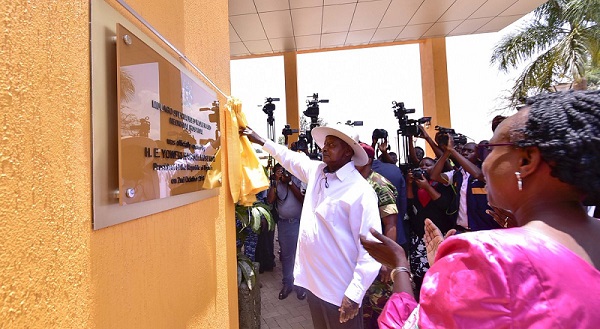
Government health facilities still use old style paper forms decades after the country adopted the referral system cascading access to care from Health Center 1 or Village Health Teams and Community Health Workers (CHEWs) as first point of care, to Health Center IVs, district hospitals, regional referrals up to the level of the national referral.
The problem was noted and in 2006, when complaints of loss of records increased, Mulago appointed a committee to assess the possibility of having a computerized record keeping system. Nothing came of it.
Plans to have this system were again hinted on in 2017 when, during a tour of the women’s hospital and renovation works at the main hospital; the Mulago Hospital Director Baterana Byarugaba announced that they were installing a cyber optic cable to implement a customized Integrated Hospital Management system to enable them share and compare patient information easily with regional referral hospitals and the Kiruddu and Kawempe annexes of Mulago hospital. This is where most of the patients referred for super specialized care are expected to be from.
Dr. Diana Atwiine, the PS says the technology and everything will be in place early next year when the refurbished Old Mulago is expected to open and a more efficient US$12 million ambulance system will be introduced to ease the referral system.
She said the National Development Plan 2020 guides the leaders to implement the referral system.
Dr. Lawrence Kazibwe, the Deputy Director at Kawempe Hospital also says what they are learning from this is that implementing a referral system is more than having structures and buildings. He gives an example that as big as his facility is, he only has three ambulances to transfer patients when they need special care.
The situation at Mulago, it appears, is putting the much touted referral system to a test and the wing facilities are feeling the pressure.
The added pressure is felt at every department at the Kawempe hospital. At the radiology department, equipment previously used in the private wing has been transferred to the new hospital. We could not verify this but only one ultra sound scan was in use when we visited and it is in the general wing.
One of the top doctors here is J.B Tezita, who is also a long time consultant obstetrician. Previously he was based at the private antenatal wing of the Obstetrics and Gynecology extension of Mulago National Referral Hospital.
Monday is a busy day for him as it is antenatal day at the private wing of Kawempe. Women and couples flock his clinic for antenatal solutions, conception interventions, and post-natal advice.
He is usually at the clinic by 8am but his patients keep increasing and queues of patients soon flow into the corridor.
Oct.29 was a typical chaotic day. Patients scrambled for sitting space on benches in front of his consultation room. But by 9am, the doctor had not arrived. The crowd kept swelling as no one was leaving. Some chose to stand – not bothered by the seemingly unclean terrazzo floor with stains of dry blood drops and a stench that occasionally swept through – probably from a pile of hospital waste behind the building.
About 30 minutes after midday, Dr. Tezita arrived. He seemed overwhelmed by the numbers.
“I had asked someone to stand in for me,” he explained, “I had a case at the women’s hospital.” Then he was interrupted by a phone call and he seemed to be giving instructions to the caller on how to handle another patient.
Then he did something unusual; he advised the women to transfer to the new women’s hospital if they want. The suggestion was odd and showed how specialists like Tezita now have to divide up their time between seeing mothers admitted at both the general and private wing, attend to those coming in for antenatal at the Private wing and specialised cases at the new hospital. It is clear they cannot wait for the referral system that Dr. Atwiine promises to kick in.
 The Independent Uganda: You get the Truth we Pay the Price
The Independent Uganda: You get the Truth we Pay the Price



Mulago referal service is overwhelmed by the number of patients .. the specialised women’ s ward did not antispace the number of patients so we’re ill prepared. A smilar situation exists in the Cancer Institute Private ward . Am a patient at the institute. The situation is pathetic too many patients few qualified staff to handle patients services are scaterrf. Blood is collected from patients at the private laboratory is in another area a distance away . One lab technician collects blood the same takes it for analysis waits for results meanwhil patients are waiting for his services the doctor is waiting results before attending to patients!! Patients normally come early to get served as early as 7am patients are lined up but do not see the Doctor until 12 noon or beyond. On getting presciption from the Doctor they have to go buy drugs required the institute does not stock the Cancer drugs specially expensive omen we have to buy from pharmacies in Wandegeya . On getting the drgs patient submit to the lab for mixing the lab is located a distance from the ward. Patient waits at the ward to receive treatment. It is responsibility of the attending to walk to and Fri collecting drags to treat patients she or he in same man providing care to more than 20 patients crowded in one small room,pathetic it is real tocher but we have no alternative but to endure.
I do symothuse with the doctors and nurses conditions under which they work are very hush. How some manage to smile to patients is a wonder not under the stressful conditions under which they operate.
I suggest the powers to be should come out honestly and admit their failure to fund health services . Let them tell the population the truth then we know what to expect rather than the falsehood which give patients wrong expectations.
Our Doctors should be treated as heroes for keeping
Hospitals open and functioning though eNding. heal